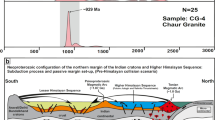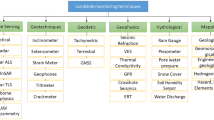Abstract
The Ms8.0 Wenchuan earthquake that occurred on 12 May 2008 in southwestern China and triggered numerous landslides is one of the stronger ones in the steep eastern margins of the Tibetan Plateau. The surfaces of these landslides have recovered gradually with vegetation, which provide useful information about the evolution of geologic environment as well as the long-term assessment of landslides after earthquake. The Mianyuanhe watershed shows many co-seismic landslides. The active fault passing through its center is selected as a study area aiming to analyze the annual surface recovery rate (SRR) of landslides by interpretation of remote-sensing images in five periods from 2008 to 2013. The results are here described. (1) Although a large amount of loose deposits were transformed into debris flows, the surfaces of the landslides recovered rapidly with vegetation and almost no landslides occurred at new sites after the Wenchuan earthquake. In the year 2008, the exposed surface projected area (ESPA) of the landslides showed a total area of 56.3 km2 and covered 28.9 % of the study area, which was reduced rapidly to 19.1 % in 2011 and 15.8 % in 2013. (2) The study area was divided into four geologic units, including clastic rocks, melange zone, carbonate rocks, and magmatic rocks. Smaller ESPAs and higher SRRs were found in the former two units versus the latter ones. (3) A single large landslide shows an SRR lower than a group of smaller ones having an equal total surface, while the SRRs of debris flows are lower than those of rockfalls and landslides. (4) The vegetation cover would return to the pre-earthquake level in 2020 approximately, which indicates that the impact of the Wenchuan earthquake on landslides and debris-flows activities would cease almost completely.







Similar content being viewed by others
References
Ahrahamson NA, Somerville PG (1996) Effects of the hanging wall and footwall on ground motions recorded during the Northridge earthquake. Bull Seismol Soc Am 86:S93–S99
He ZT, Ma BQ, Li YS, Hao YJ, Sha P (2012) Width and hanging wall effect of surface rupture caused by Wenchuan earthquake. Acta Scientiarum Naturalium Universitatis Pekinensis, pp 886–894
Huang RQ (2011) After effect of geohazards induced by the Wenchuan earthquake. J Eng Geol 19:145–151
Huang RQ, Li WL (2014) Post-earthquake landsliding and long-term impacts in the Wenchuan earthquake area, China. Eng Geol 182(partB):111–120
Huete AR (1988) A soil-adjusted vegetation index (SAVI). Remote Sens Environ 25:295–309
Keefer DK (1994) The importance of earthquake-induced landslides to long-term slope erosion and slope-failure hazards in seismically active regions. Geomorphology 10:265–284
Khattak GA, Owen LA, Ulrich K, Harp EL (2010) Evolution of earthquake-triggered landslides in the Kashmir Himalaya, northern Pakistan. Geomorphology 115:102–108
Li WL, Huang RQ, Tang C, Xu Q (2011) Landslides triggered by “5.12” Wenchuan earthquake in the Mianyuan River basin, China. J Mt Sci 29:483–492
Li LJ, Yao X, Zhang YS, Chen J (2014) RS-based extraction and distribution characteristics of geo-hazards triggered by Wenchuan earthquake in Mianyuan River basin. J Eng Geol 22:46–55
Liang JT, Wang J, Song Y, Ma XB (2012) Temporal evolution of typical debris flows in Wenchuan earthquake areas: case study of Zoumaling-gully debris flows in Mianzhu County. J Eng Geol 20:318–325
Lin CW, Shieh CL, Yuan BD, Shieh YC, Liu SH, Lee SY (2003) Impact of Chi-Chi earthquake on the occurrence of landslides and debris flows: example from the Chenyulan River watershed, Nantou, Taiwan. Eng Geol 71:49–61
Lin CW, Liu SH, Lee SY, Liu CC (2006a) Impacts of the Chi-Chi earthquake on subsequent rainfall-induced landslides in central Taiwan. Eng Geol 86:87–101
Lin WT, Lin CY, Chou WC (2006b) Assessment of vegetation recovery and soil erosion at landslides caused by a catastrophic earthquake: a case study in central Taiwan. Ecol Eng 28:79–89
Lin WT, Chou WC, Lin CY, Huang PH, Tsai JS (2007) Study of landslides caused by the 1999 Chi-Chi earthquake, Taiwan, with multitemporal SPOT images. Remote Sens 33:289–302
Lin WT, Chou WC, Lin CY (2008) Earthquake-induced landslide hazard and vegetation recovery assessment using remotely sensed data and a neural network-based classifier: a case study in central Taiwan. Nat Hazards 47:331–347
Lin CY, Chuang CW, Lin WT, Chou WC (2010) Vegetation recovery and landscape change assessment at Chiufenershan landslide area caused by Chichi earthquake in central Taiwan. Nat Hazards 53:175–194
Nakamura H, Tsuchiya S, Inoue K et al (2000) Sabo against earthquakes. KokonShoin, Tokyo, pp 190–220
Scheingross JS, Minchew BM, Mackey BH, Simons M, Lamb MP, Hensley S (2013) Fault zone controls on the spatial distribution of slow-moving landslides. Geol Soc Am Bull 125:473–489
Shou KJ, Hong CY, Wu CC, Hsu HY, Fei LY, Lee JF, Wei CY (2011) Spatial and temporal analysis of landslides in central Taiwan after 1999 Chi-Chi earthquake. Eng Geol 123:122–128
Xu XW, Wen XZ, Ye JQ, Ma BQ, Chen J, Zhou RJ, He HL, Tian QJ, He YL, Wang ZC, Sun ZM, Feng XJ, Yu GH, Chen LC, Chen GH, Yu SE, Ran YK, Li XG, Li CX, An YF (2008) The Ms8.0 Wenchuan earthquake surface ruptures and its seismogenic structure. Seismol Geol 30:597–629
Xu X, Wen X, Yu G, Chen G, Klinger Y, Hubbard J, Shaw J (2009) Coseismic reverse- and oblique-slip surface faulting generated by the 2008 Mw7.9 Wenchuan earthquake, China. Geology 37:515–518
Yao X, Zhang YS, Wang XL, Xiong TY (2008) Automatic hierarchical approach to detecting shallow landslides and avalanches by the combination of multi-spectral RS imagery and DEM derivatives. Geol Bull China 27:1870–1874
You Y, Chen XZ, Liu JF (2011) “8.13” extra large debris flow disaster in Wenjia gully of Qingping township, Mianzhu, Sichuan Province. J Catastrophol 26:68–72
Zhang Y, Guindon B (2012) Multispectral analysis for manmade surface extraction from RapidEye and SPOT5. Can J Remote Sens 38:180–196
Acknowledgments
This research is supported by the Project of the 12th Five-year National Sci-Tech Support Plan of China (2011BAK12B09) and China Geological Survey (1212010914025, 1212011014033). We are grateful to Yu Kai and Wang Zongsheng for their help during field investigations. Special thanks to Wang Pengfei and Long Wei for their valuable suggestions for completing this task. We are thankful to editor and anonymous reviewers for their constructive comments which greatly helped to improve the original manuscript.
Author information
Authors and Affiliations
Corresponding author
Rights and permissions
About this article
Cite this article
Li, L., Yao, X., Zhang, Y. et al. Surface recovery of landslides triggered by 2008 Ms8.0 Wenchuan earthquake (China): a case study in a typical mountainous watershed. Landslides 13, 787–794 (2016). https://doi.org/10.1007/s10346-015-0594-1
Received:
Accepted:
Published:
Issue Date:
DOI: https://doi.org/10.1007/s10346-015-0594-1




